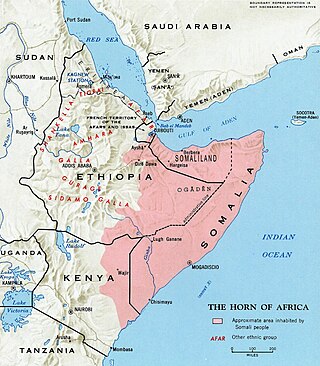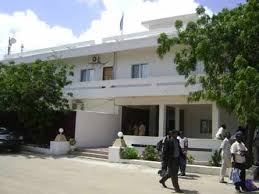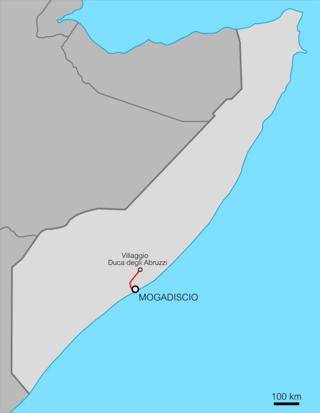See also
| Italian languages & dialects | |
|---|---|
| Pidgin & Mixed | |
1 autochthonous | |
It is proposed that this article be deleted because of the following concern:
If you can address this concern by improving, copyediting, sourcing, renaming, or merging the page, please edit this page and do so. You may remove this message if you improve the article or otherwise object to deletion for any reason. Although not required, you are encouraged to explain why you object to the deletion, either in your edit summary or on the talk page. If this template is removed, do not replace it . The article may be deleted if this message remains in place for seven days, i.e., after 00:37, 15 September 2023 (UTC). Find sources: "Pidgin Italian of Somalia" – news · newspapers · books · scholar · JSTOR Nominator: Please consider notifying the author/project: {{ subst:proposed deletion notify |Pidgin Italian of Somalia|concern=[[WP:G5]]: Created by banned user [[User:Brunodam|Brunodam]] through recently confirmed sockpuppet Ken93y. See current case page [[Wikipedia:Sockpuppet investigations/Brunodam]] or, once archived, [[Wikipedia:Sockpuppet_investigations/Brunodam/Archive]].}} ~~~~ |
Another editor has reviewed this page's proposed deletion , endorses the proposal to delete, and adds: If you remove the {{proposed deletion/dated}} tag above, please also remove this {{Proposed deletion endorsed}} tag. |
| Pidgin Italian of Somalia | |
|---|---|
| Simplified Italian of Somalia | |
| Region | Somalia |
| Era | 19th to late-20th centuries |
Italian-based pidgin | |
| Language codes | |
| ISO 639-3 | None (mis) |
Pidgin Italian of Somalia (also called "Somali Italian Pidgin" or "Simplified Italian of Somalia") is an indigenous language of Italian Somaliland. It is the result of mixing Italian with Somalian language and was used mainly in the first half of the 20th century by many of the Somalian population (mainly in the capital Mogadishu).
The pidgin spoken in Italian Somaliland was important in the capital Mogadishu and in some smaller cities (such as Merca and Villabruzzi), especially in the 1930s and 1940s.
Almost all of Mogadishu's native inhabitants understood the Italian language in 1941, while half of them could speak Italian using the "Somali Pidgin Italian".
During the United Nations trusteeship period from 1949 to 1960, Italian along with Somali were used at the official level internally, while the main working language of the UN, English, was the language used during diplomatic correspondence, international issues and occasionally economic deals. After independence in 1960, Italian remained official for another nine years. Italian was later declared an official language again by the Transitional Federal Government along with English in 2004. But, in 2012, it was removed from the Interim Constitution of the Federal Government of Somalia, leaving Somali and Arabic as the only official languages.
Italian is a legacy of Somalia's Italian colonial period when it was part of the Italian Empire. Italian - of course - was the mother tongue of the Italian settlers in Somalia.
The Somali school system in the colonial era before World War II was only in Italian-language and mainly limited to primary schools and some secondary schools (such as the "Scuola Regina Elena").
But in the capital Mogadishu of "Italian Somalia" there was an important secondary school: The "Lyceum De Bono" of Mogadishu. In this Lyceum, the "National Institute of Legal, Economic and Social Studies" was created at the beginning of the 1950s, as an Italian-language post-secondary school for pre-university studies to access Italian universities.
Although it was the main language since colonial rule, Italian continued to be used among the country's ruling elite even after independence in 1960, when it remained the official language. It is estimated that more than 200,000 native Somalis (nearly 20% of the total population of the former Italian Somaliland) spoke fluent Italian and/or Somali Pidgin Italian when the Somalia's independence was declared in 1960.
After a military coup in 1969, all foreign entities were nationalized by Siad Barre (who was fluent in Italian [1] and "Pidgin Italian of Somalia"), including Mogadishu's main university, which was renamed 'Jaamacadda Ummadda Soomaliyeed' (Somali National University). This marked the initial decline in the use of Italian in Somalia.
However, Italian is still widely spoken by the elderly, the educated, and government officials of Somalia. Approximately 5,000 Somalis knew and/or used "Somali Italian Pidgin" in 2010, according to historian Massimo Della Volpe. Furthermore, the academic Tosco pinpointed that the romanicization of the Somalian language is very weak, but even so nearly 24% of the Somalian words are loanworded from the Italian [2]
Before the Somali civil war, Mogadishu still had an Italian language school, but it was later destroyed during the conflict.
There are nearly 500 Italian words loanworded in the Pidgin Italian of Somalia, according to researcher D'Ambrosio. These are some of the most used:
Pidgin - Italian (English)
Boorso – Borsa (bag)
Goono – Gonna (skirt)
Jalaato – Gelato (ice cream)
Katiinad – Cateena (chain)
Rajastiin/rajabeeto – reggiseno/reggipetto (bra)
Foorno – Forno (oven)
Toosh – Torcia (torch)
Okayaalo – Occhiali (glasses)
Kooba diin – Comodino (night table)
Katabaan – Attaccapanni (coat hanger)
Armaajo – Armadio(wardrobe)
Suugo – Sugo (sauce)
Doorshe Doolshe – Dolce (cake)
Fargeeto – Forchetta (fork)
Fiilo – Filo (cord)
Jaalo – Giallo (yellow)
Taako – Tacco (heels)
Injineer - Ingegnere (engineer)
Agoosto - Agosto (August)
Febraayo - Febbraio (February)

Somalia, officially the Federal Republic of Somalia, is a country in the Horn of Africa. The country is bordered by Ethiopia to the west, Djibouti to the northwest, the Gulf of Aden to the north, the Indian Ocean to the east, and Kenya to the southwest. Somalia has the longest coastline on Africa's mainland. Its terrain consists mainly of plateaus, plains, and highlands. Hot conditions prevail year-round, with periodic monsoon winds and irregular rainfall. Somalia has an estimated population of around 17.1 million, of which over 2 million live in the capital and largest city Mogadishu, and has been described as Africa's most culturally homogeneous country. Around 85% of its residents are ethnic Somalis, who have historically inhabited the country's north. Ethnic minorities are largely concentrated in the south. The official languages of Somalia are Somali and Arabic. Most people in the country are Muslims, the majority of them Sunni.
Somalia, officially the Federal Republic of Somalia and formerly known as the Somali Democratic Republic, is a country located in the Horn of Africa. The country was an important centre for commerce with the rest of the ancient world, and according to most scholars, it is among the most probable locations of the fabled ancient Land of Punt. During the Middle Ages, several powerful Somali states and port towns dominated the regional trade, the Mogadishu Sultanate and Ajuran Sultanate both centered around the port town Mogadishu, but also the port towns of Barawe and Merca.

Italian East Africa was an Italian colony in the Horn of Africa. It was formed in 1936 after the Second Italo-Ethiopian War through the merger of Italian Somalia, Italian Eritrea, and the newly occupied Ethiopian Empire.

The Horn of Africa (HoA), also known as the Somali Peninsula, is a large peninsula and geopolitical region in East Africa. Located on the easternmost part of the African mainland, it is the fourth largest peninsula in the world. It is composed of Ethiopia, Eritrea, Somalia and Djibouti; broader definitions also include parts or all of Kenya, Sudan, South Sudan, and Uganda. The term Greater Horn Region (GHR) can additionally include Burundi, Rwanda, and Tanzania. It lies along the southern boundary of the Red Sea and extends hundreds of kilometres into the Guardafui Channel, Gulf of Aden, and Indian Ocean and shares a maritime border with the Arabian Peninsula of Western Asia.

Italian Somaliland was a protectorate and later colony of the Kingdom of Italy in present-day Somalia. Ruled in the 19th century by the Somali Sultanates of Hobyo and Majeerteen in the north, and in the south by political entities such as the Hiraab Imamate and Geledi Sultanate.

Greater Somalia is a concept to unite all ethnic Somalis comprising the regions in or near the Horn of Africa in which ethnic Somalis live and have historically inhabited. The territory historically encompassed British Jubaland Province, British Somaliland, Italian Somaliland, parts of French Somaliland, the Somali Region in Ethiopia, the Northern Frontier District in Kenya, and the intra-46th meridian east territories. At the present, it encompasses Somalia proper, Jubaland, southern and eastern Djibouti, the Somali Region and Dire Dawa in Ethiopia, and the Garissa, Wajir and Mandera Counties in Kenya.

The history of Somaliland, a country in the eastern Horn of Africa bordered by the Gulf of Aden, and the East African land mass, begins with human habitation tens of thousands of years ago. It includes the civilizations of Punt, the Ottomans, and colonial influences from Europe and the Middle East.

The endoglossic language of Somalia has always been Somali, although throughout Somalia's history various exoglossic languages have also been used at a national level.

The Somali Youth League, initially known as the Somali Youth Club (SYC), was the first political party in Somalia.
The Somali Rebellion was the beginning of the civil war in Somalia that occurred in the 1980s and early 1990s. The rebellion started in 1978 when President Siad Barre began using his special forces, the "Red Berets", to attack clan-based dissident groups opposed to his regime. The dissidents had been becoming more powerful for nearly a decade following his abrupt switch of allegiance from the Soviet Union to the United States and the disastrous 1977-78 Ogaden War.

Villa Somalia is a building in Mogadishu, the capital of Somalia. It serves as the palace and principal workplace of the president of Somalia. The current president is Hassan Sheikh Mohamud (HSM).

The Trust Territory of Somaliland, officially the "Trust Territory of Somaliland under Italian administration", was a United Nations Trust Territory situated in present-day Somalia. Its capital was Mogadishu and was administered by Italy from 1950 to 1960, following the dissolution of the former British Military Administration. It gained independence in 1960.

Italian Somalis are Somali-born citizens who are fully or partially of Italian descent, whose ancestors were Italians who emigrated to Somalia during the Italian diaspora, or Italian-born people in Somalia. Most of the Italians moved to Somalia during the Italian colonial period.

The Mogadiscio–Villabruzzi Railway is an historical railway system that ran through southern Somalia. It was constructed between 1914 and 1927 by the colonial authorities in Italian Somaliland. The railway connected the capital city Mogadishu with Afgooye, and subsequently with Villaggio Duca degli Abruzzi – usually called "Villabruzzi". The line was later dismantled by British troops during World War II. Plans for re-establishing the railway were made in the 1980s by the Siad Barre administration, but were aborted after the regime's collapse.

The military history of Somalia encompasses the major conventional wars, conflicts and skirmishes involving the historic empires, kingdoms and sultanates in the territory of present-day Somalia, through to modern times. It also covers the martial traditions, military architecture and hardware employed by Somali armies and their opponents.

The Royal Corps of Somali Colonial Troops was the colonial body of the Royal Italian Army based in Italian Somaliland, in present-day northeastern, central and southern Somalia.
Eritrean Pidgin Italian was a pidgin language used in Italian Eritrea when Eritrea was a colony of Italy.

The Petrella Airport was the first international airport in Italian Somalia. It was opened in 1928 -just 3 miles south of Mogadishu- with the name "Enrico Petrella" in honor of an Italian pilot who died a few years before in the same airport of Italian Mogadiscio. In 1941 the airport was partially destroyed during WW2 and remained inactive for some years as a civilian airport: only military airplanes used it. In 1950 was reopened as a civilian airport by the Italian authorities of the ONU Fiduciary Mandate.
The Pidgin Italian of Ethiopia was a pidgin language used by some Ethiopians in the 20th century to speak in a form of Italian. It was used mainly in the north of Ethiopia and in the capital, Addis Ababa, when Ethiopia was part of the Italian empire up to World War II. It remained in use among some old Ethiopians and Eritreans until the 2020s.
There was a Pidgin Italian of Libya in the Italian colony of Libya, that survived until the 1980s. Sometimes, "Libyan Italian" (LI) is the name given to the Italian language used by native population in the North African nation of Libya., mainly in the Tripolitania region.